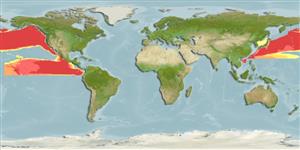Classification / Names
Common names | Synonyms | Catalog of Fishes(genus, species) | ITIS | CoL | WoRMS | Cloffa
Teleostei (teleosts) >
Lophiiformes (Anglerfishes) >
Oneirodidae (Dreamers)
Etymology: Oneirodes: Greek, 'oneiros' = a dream or dreamlike or out of a dream (suggesting this fish is so strange and marvelous that can exist only in dreams) (Ref. 86949); pietschi: Named in honor of Professor Theodore W. Pietsch of the College of Ocean and Fishery Sciences, University of Washington, Seattle, in recognition of his many contributions to our knowledge of ceratioid anglerfishes (Ref. 51069).
Eponymy: Dr Theodore ‘Ted’ Wells Pietsch III (d: 1945) was a professor of ichthyology at the University of Washington, Seattle (1978 onwards) and is an American systematist and evolutionary biologist especially known for his studies of anglerfishes. [...] (Ref. 128868), visit book page.
Environment: milieu / climate zone / depth range / distribution range
Ecology
Marine; bathypelagic; depth range 300 - 1635 m (Ref. 86949). Deep-water
Southeast Indian Ocean and central Pacific.
Size / Weight / Age
Maturity: Lm ? range ? - ? cm
Max length : 11.7 cm SL male/unsexed; (Ref. 51069); 10.0 cm SL (female)
Short description
Identification keys | Morphology | Morphometrics
Dorsal soft rays (total): 6; Anal soft rays: 4. Belonging to the Oneirodes schmidti-group. Lacking an anterior escal apparatus. Escal morphology: a pair of simple, elongate, anterolateral escal appendages, without internal pigmentation; a pair of simple, elongate, medial escal appendages, each divided distally into three or more short, slender filaments; a simple, elongate, and anteroposteriorly compress posterior escal appendage, slightly expanded distally; all appendages without pigmentation; terminal escal papilla with or without a pair of small distal pigment spots (Ref. 51069). Characterized further by absence of epibranchial teeth; presence of teeth on pharyngobranchial II; upper jaw teeth 32-58, lower jaw teeth 34-42; teeth on vomer 4-6; dorsal fin rays 6; anal fin rays 4; pectoral fin rays 14-16; head length 34-41% SL; head depth 35-43% SL; premaxilla length 27-31% SL; length of lower jaw 35-42% SL; length of illicium 29-49% SL (Ref. 86949).
Benthopelagic (Ref. 58302).
Life cycle and mating behavior
Maturity | Reproduction | Spawning | Eggs | Fecundity | Larvae
Ho, H.-C. and K.-T. Shao, 2004. New species of deep-sea ceratioid anglerfish, Oneirodes pietschi (Lophiiformes: Oneirodidae), from the North Pacific Ocean. Copeia 2004(1):74-77. (Ref. 51069)
IUCN Red List Status (Ref. 130435: Version 2024-1)
Threat to humans
Harmless
Human uses
Tools
Special reports
Download XML
Internet sources
Estimates based on models
Preferred temperature (Ref.
123201): 3.7 - 5.8, mean 5.6 °C (based on 21 cells).
Phylogenetic diversity index (Ref.
82804): PD
50 = 0.5000 [Uniqueness, from 0.5 = low to 2.0 = high].
Bayesian length-weight: a=0.01995 (0.00906 - 0.04395), b=3.01 (2.83 - 3.19), in cm total length, based on all LWR estimates for this body shape (Ref.
93245).
Trophic level (Ref.
69278): 4.0 ±0.7 se; based on size and trophs of closest relatives
Resilience (Ref.
120179): Medium, minimum population doubling time 1.4 - 4.4 years (Preliminary K or Fecundity.).
Fishing Vulnerability (Ref.
59153): Low vulnerability (10 of 100).
